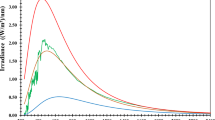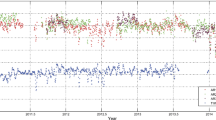Abstract
Defining the solar brightness temperature accurately at millimeter wavelengths has always been challenging. One of the main reasons has been the lack of a proper calibration source. New Moon was used earlier as a calibration source. We carried out a new extensive set of observations at 8 mm using the New Moon for calibration. The solar and Moon observations were made using the 14-meter radiotelescope operated by the Aalto University Metsähovi Radio Observatory in Finland. In this article, we present our method for defining the brightness temperature of the quiet-Sun level (QSL). Based on these observations, we found \(8100~\mbox{K} \pm 300~\mbox{K}\) to be the mean value for the QSL temperature. This value is between the values that were reported in earlier studies.
Similar content being viewed by others
Avoid common mistakes on your manuscript.
1 Introduction
The Sun is also a powerful emitting source at radio wavelengths, and partly because of this, defining its brightness temperature is challenging. In several earlier studies, the Moon has been used as a calibrator source (Wrixon, 1974; Zirin, Baumert, and Hurford, 1991; Iwai et al., 2017).
In this study we use the New Moon as a calibrator source at 8 mm, and we produce several datasets from which we obtain a new reference value for the solar brightness temperature. All the other solar features (e.g. radio brightenings) can be scaled to the quiet-Sun level (QSL) temperature. In addition, the more precise QSL temperature value could explain which atmospheric layer the 8 mm emission is coming from.
Measuring the solar brightness temperature accurately requires favorable conditions to eliminate the effects contributed by the changing sky, and the measurements should be made during solar minimum when no major activity complicates the data analysis.
The emission at 8 mm originates from the upper chromosphere, which is hotter than the Sun’s visible surface in the photosphere. At least the following values for the QSL brightness temperature at 8 mm have been reported earlier: \(7050~\mbox{K} \pm 800~\mbox{K}\) (Urpo et al., 1981), 7800 K (Urpo and Pohjolainen, 1987), \(8300~\mbox{K} \pm 300~\mbox{K}\) (Landi and Chiuderi Drago, 2008), \(9131\,\mbox{--}\,9443~\mbox{K}\) (Linsky, 1973), and 9310 K (Kuseski and Swanson, 1976). In the most recent studies (Kallunki and Uunila, 2017; Kallunki and Tornikoski, 2017), \(8300~\mbox{K}\pm 300~\mbox{K}\) has been used as a reference for the QSL brightness temperature.
In this article we present our instrumentation, observations, analysis method, and results for calibrating the QSL temperature.
2 The Brightness Temperature of the Moon at 8 mm
The mean brightness temperature of the Moon (\(T_{\mathrm{moon}}\)) at millimeter wavelengths consists of two different components, and it depends on the observing frequency (\(\nu \)) (Hafez et al., 2014; Krotikov and Pelyushenko, 1987). The first component \(T_{0}(\nu )\) is a constant (214 K at 8 mm), and the second component \(T_{1}\) (38 K at 8 mm) varies with the lunar phase. Thus, the mean brightness temperature of the Moon can be defined as
where \(\omega \) is the angular frequency of the lunar cycle (\(12.26^{\circ}\) per day) and \(\xi ({\nu })\) is the phase relative to the time of New Moon (\(32^{\circ }\) at 8 mm). During the New Moon, \(\omega t \approx 0\). Thus, the mean brightness temperature of the Moon at 8 mm is 246.2 K during the New Moon (Krotikov and Pelyushenko, 1987; Hafez et al., 2014).
Some other values for the New Moon brightness temperature have been reported as well: 216 K at 8.3 mm (the disk center temperature) (Kuseski and Swanson, 1976), and \(239.5 \pm 10.1~\mbox{K}\) (mean temperature) and 219 K (the disk center temperature) at 10 mm (Linsky, 1973). In this article we use the value obtained from Equation 1.
3 Instrumentation
Observations were carried out at the Aalto University Metsähovi Radio Observatory (MRO) in Finland (Helsinki region; GPS coordinates: N 60:13.04, E 24:23.35). The solar and lunar radio maps were observed at 8 mm in four sessions close to the occurrence of the New Moon with the MRO 14-meter radiotelescope (RT-14), shown in Figure 1. RT-14 is a radome-enclosed Cassegrain-type antenna with a diameter of 13.7 m. The usable wavelength range of the telescope is 13.0 cm – 2.0 mm. During solar observing sessions, the antenna is used for solar mapping, partial mapping, and tracking of any selected areas on the solar disk. The beam size of the telescope is 2.4 arc min at 8 mm, marked as white circles in Figures 2 and 3. The receiver is a Dicke-type radiometer with a Peltier element temperature stabilization and with a noise temperature of approximately 280 K.
The temporal resolution during observations is 0.1 s or lower. The data are recorded in intensities. Solar radio maps can be observed in both linear and logarithmic scales and measured in both right ascension and declination directions. The logarithmic scale data are used only for strong solar radio brightenings. The time between two consecutive solar radio maps is around 172 seconds at fastest.
Before 2016, the time between maps was approximately 8 minutes, but after our observing system and position controller software upgraded, it is possible to make more extensive Sun–Moon-calibration measurements with a sample count of approximately three times better than before.
Because the measurements are always scaled relative to the QSL, our observations are comparable over the years. QSL is the median temperature of the data samples of the solar disk in the radio maps (Kallunki et al., 2012; Kallunki and Tornikoski, 2017).
4 Observations
The first of four observing sessions was carried out in March at the time of the New Moon, the other sessions in May were offset by one to three days from the New Moon. During all these sessions, the observing conditions were nearly optimal, and the activity of the Sun at 8 mm was low.
During the March session (on 17 March 2018), solar and lunar radio maps were obtained in turns from 06:30 UT to 15:30 UT. As an example, one solar and lunar map from this session are presented in Figures 2 and 3. It took 172 seconds to observe one map. We excluded observations below \(15^{\circ }\) of elevation from our data analysis because of possibly pronounced atmospheric effects. In general, the atmospheric conditions were very good during the observations, with a clear sky and no clouds at all. Solar activity was very low during the session, with the maximum brightness temperature relative to the QSL not exceeding 103%. Higher solar activity could distort the determination of the QSL temperature value.
The Moon culminated at \(24.5^{\circ }\) of elevation. Therefore, only observations between \(15^{\circ }\,\mbox{--}\,24.5^{\circ }\) of elevation were included in the analysis. In total, we had about 40 solar and lunar radio maps in our final calculations.
Each solar and lunar map consists of 29 sweeps (Figure 4) over the solar or lunar disk. For each map, the minimum value is defined as the background temperature, \(T_{\mathrm{bg}}\), which is the summed contribution of the sky temperature, \(T_{\mathrm{sky}}\), and the noise from the receiver system, \(T_{\mathrm{system}}\). The intensity level of the quiet Sun, QSL (and a similar value from the lunar maps), consists in reality of the true QSL temperature and the contribution from \(T_{\mathrm{bg}}\). Throughout this study, the solar and lunar maps were not observed exactly at the same time, nor exactly in the same direction. Our method was chosen to minimize the effects from the possibly changing sky contribution, without the need for more elaborate atmospheric models. A minor contribution may remain in the solar maps also from the solar radiation in the minimum data point, but the effect on the final brightness temperature calculation is approximately 15 K at most.
The observed QSL intensity, \(T_{\mathrm{qsl},\mathrm{obs}}\), is computed to be the median intensity on the solar disk, where the solar disk is assumed to include all the data points that have an intensity value higher than 50% of the whole intensity range within which the data points fall. The similar lunar intensity, \(T_{\mathrm{qml},\mathrm{obs}}\), is the mean temperature over the lunar disk. The Moon has a greater temperature gradient, and the mean value needs to be used (Krotikov and Pelyushenko, 1987; Hafez et al., 2014). This is also evident from Figure 3.
In Figure 4 the upper dashed line indicates the QSL intensity and the lower dashed line the background contribution, \(T_{\mathrm{bg},\mathrm{sun}}\). The real QSL that we wish to determine from these observations is \(T_{\mathrm{qsl}} = T_{\mathrm{qsl},\mathrm{obs}}-T_{\mathrm{bg},\mathrm{sun}}\).
We assume that the sky temperature, \(T_{\mathrm{sky}}\), is the same at the same elevations during the solar and lunar observations under these near optimal conditions, and we eliminate the effect of the changing elevation during each map by applying a cosine correction, \(\cos(\mathit{el})\), to the sweeps. All the intensity values discussed above are in arbitrary units, and the brightness temperatures were calculated from them in Kelvin.
In Figures 5, 6, 7, and 8 we present a summary of all observations: the background temperatures (\(T_{\mathrm{bg},\mathrm{sun}}\), \(T_{ \mathrm{bg},\mathrm{moon}}\)) during the solar and lunar observations, respectively, the QSL and the mean Moon intensities including the background contribution (\(T_{\mathrm{qsl},\mathrm{obs}}\), \(T_{\mathrm{qml},\mathrm{obs}}\)), and after subtracting the background contribution (\(T_{\mathrm{qsl}}\), \(T_{\mathrm{qml}}\)).
Summary of all observations on 17 March 2018: the background temperatures (\(T_{\mathrm{bg},\mathrm{sun}}\), \(T_{\mathrm{bg},\mathrm{moon}}\)) during the solar and lunar observations, the observed QSL and Moon mean intensities including the background (\(T_{\mathrm{qsl},\mathrm{obs}}\), \(T_{ \mathrm{qml},\mathrm{obs}}\)), and the real quiet-Sun and Moon temperatures (\(T _{\mathrm{qsl}}\), \(T_{\mathrm{qml}}\)). The rising elevation is marked with the circles and the descending elevation with the pluses.
Summary of all observations on 12 May 2018: the background temperatures (\(T_{\mathrm{bg},\mathrm{sun}}\), \(T_{\mathrm{bg},\mathrm{moon}}\)) during the solar and lunar observations, the observed QSL and Moon mean intensities including the background (\(T_{\mathrm{qsl},\mathrm{obs}}\), \(T_{ \mathrm{qml},\mathrm{obs}}\)), and the real quiet-Sun and Moon temperatures (\(T _{\mathrm{qsl}}\), \(T_{\mathrm{qml}}\)). The rising elevation is marked with the circles and the descending elevation with the pluses.
Summary of all observations on 14 May 2018 the background temperatures (\(T_{\mathrm{bg},\mathrm{sun}}\), \(T_{\mathrm{bg},\mathrm{moon}}\)) during the solar and lunar observations, the observed QSL and Moon mean intensities including the background (\(T_{\mathrm{qsl},\mathrm{obs}}\), \(T_{ \mathrm{qml},\mathrm{obs}}\)), and the real quiet-Sun and Moon temperatures (\(T _{\mathrm{qsl}}\), \(T_{\mathrm{qml}}\)).
Summary of all observations on 16 May 2018: the background temperatures (\(T_{\mathrm{bg},\mathrm{sun}}\), \(T_{\mathrm{bg},\mathrm{moon}}\)) during the solar and lunar observations, the observed QSL and Moon mean intensities including the background (\(T_{\mathrm{qsl},\mathrm{obs}}\), \(T_{ \mathrm{qml},\mathrm{obs}}\)), and the real quiet-Sun and Moon temperatures (\(T _{\mathrm{qsl}}\), \(T_{\mathrm{qml}}\)).
The arbitrary intensity units are converted into real temperature values in Kelvin using
Because we can observe the sky and the source almost simultaneously and in many successively repeated observations, we did not have to use rather complicated atmospheric emission and attenuation models. From our data we can see that the sky value does not vary more than 5% over the observation period, making its effect on the final results negligible. Additionally, from our earlier solar observations we know that the effect of the sidelobe distortion on map measurements is negligibly small.
The observations were repeated on three other days close to the occurrence of the New Moon in May 2018: 12 May (−3 days from New Moon), 14 May (−1 day from New Moon), and 16 May (\(+1\) day from New Moon). All the observations and data processing were made using similar methods and principles as described above. A summary of all observations is presented in Table 1.
On 17 March 2018, the observations were conducted in both the rising and descending elevation. The symbols shown in Figure 5 for the solar observations that almost overlap in elevation were therefore taken with a relatively large time difference.
5 Results
Owing to observational constraints, we did not have an identical number of solar and lunar maps in each observing session. We therefore do not calculate the results for \(T_{\mathrm{sun}}\) for each pair of solar and lunar maps, but rather for the whole set of observations in each session. We wish to use the complete dataset taken at reasonably high elevations to obtain meaningful statistics and to eliminate the effect of the sky contribution.
We calculate the mean, minimum, and maximum values for each parameter, as shown in Figures 5 – 8. Using Equation 2, we derive the values shown in Table 1 for each observing day. The mean values for all the observing sessions, i.e. of each column in Table 1, are the mean QSL brightness temperature, \(T_{ \mathrm{qsl},\mathrm{avg}}=8085~\mbox{K}\), the minimum QSL brightness temperature, \(T_{\mathrm{qsl},\mathrm{min}}=7886~\mbox{K}\), and the maximum QSL brightness temperature, \(T_{\mathrm{qsl},\mathrm{max}}=8402~\mbox{K}\). The minimum and maximum values are used to estimate the measurement error. From our measurements we conclude that the solar brightness temperature at 8 mm is \(8100~\mbox{K} \pm 300~\mbox{K}\).
6 Conclusion and Discussions
We have carried out measurements of the solar brightness temperature during solar activity minimum and under optimal weather conditions in four sessions close to the occurrence of the New Moon, using the New Moon as the calibration source. The measurements consist of fast repeated observations of solar and lunar maps made at approximately the same elevation, where approximately the same sky temperature can be assumed and the data handling becomes straightforward.
We obtain a value \(8100~\mbox{K} \pm 300~\mbox{K}\) for the QSL brightness temperature at 8 mm. This value falls between the values that have mostly been used in the literature so far, 7800 K and 8300 K (Urpo and Pohjolainen, 1987; Landi and Chiuderi Drago, 2008).
This observing campaign was the first extensive attempt to define the 8 mm brightness temperature for the QSL at MRO. In the future we will dedicate some more telescope time to complement these data with new observations. This requires a favorable combination in which the telescope time availability matches the occurrence of the New Moon during the months when the solar elevation is sufficiently high at this northern location (between March and September), the observing conditions are optimal, and the solar activity remains low.
References
Hafez, Y.A., Trojan, L., Albaqami, F.H., Almutairi, A.Z., Davies, R.D., Dickinson, C., Piccirillo, L.: 2014, Mon. Not. Roy. Astron. Soc. 439, 2271. ADS . DOI .
Iwai, K., Shimojo, M., Asayama, S., Minamidani, T., White, S., Bastian, T., Saito, M.: 2017, Solar Phys. 292, 22. ADS . DOI .
Kallunki, J., Tornikoski, M.: 2017, Solar Phys. 292, 84. ADS . DOI .
Kallunki, J., Uunila, M.: 2017, Astron. Nachr. 338, 398. ADS . DOI .
Kallunki, J., Lavonen, N., Järvelä, E., Uunila, M.: 2012, Balt. Astron. 21, 255. ADS . DOI .
Krotikov, V.D., Pelyushenko, S.A.: 1987, Soviet Astron. 31, 216. ADS .
Kuseski, R.A., Swanson, P.N.: 1976, Solar Phys. 48, 41. ADS . DOI .
Landi, E., Chiuderi Drago, F.: 2008, Astrophys. J. 675, 1629. ADS . DOI .
Urpo, S., Pohjolainen, S.: 1987, Hvar Obs. Bull. 11, 137. ADS .
Urpo, S., Tiuri, M., Tlamicha, A., Pracka, M., Karlicky, M.: 1981, Astron. Astrophys. 93, 121. ADS .
Zirin, H., Baumert, B.M., Hurford, G.J.: 1991, Astrophys. J. 370, 779. ADS . DOI .
Acknowledgements
Open access funding provided by Aalto University.
Author information
Authors and Affiliations
Corresponding author
Ethics declarations
Disclosure of Potential Conflict of Interest
The authors declare that they have no conflicts of interest.
Rights and permissions
Open Access This article is distributed under the terms of the Creative Commons Attribution 4.0 International License (http://creativecommons.org/licenses/by/4.0/), which permits unrestricted use, distribution, and reproduction in any medium, provided you give appropriate credit to the original author(s) and the source, provide a link to the Creative Commons license, and indicate if changes were made.
About this article
Cite this article
Kallunki, J., Tornikoski, M. Measurements of the Quiet-Sun Level Brightness Temperature at 8 mm. Sol Phys 293, 156 (2018). https://doi.org/10.1007/s11207-018-1380-8
Received:
Accepted:
Published:
DOI: https://doi.org/10.1007/s11207-018-1380-8












